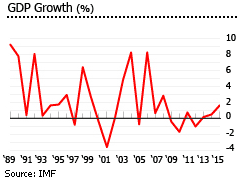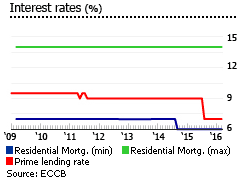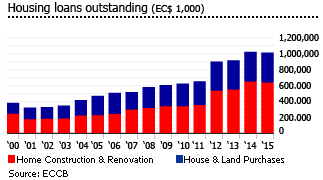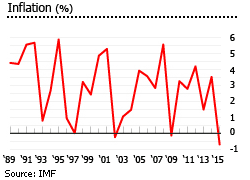St. Lucia's thriving property market
St. Lucia's property market is vibrant once more, thanks to continued growth in tourism, coupled with the introduction of the Citizenship by Investment program. The property market is largely dependent on tourism, because most buyers of luxury homes start out as tourists.
Property buyers who invest in St. Lucia "are persons who have visited and have developed a love affair with the destination," said Jason Applewhite of Christie's International Real Estate. Most foreign homebuyers in St. Lucia come from the United States, Canada, and the United Kingdom.
Aside from the increased interest from foreign homebuyers, developers and investors are also starting to return to St. Lucia, according to local property experts.
Property prices dropped 20% to 30% from 2009 to 2014, due to the global crisis. The housing market started to pick up only at the end of 2014.
"People have recognized that we have hit the bottom, and there literally has not been a better time to buy property in St. Lucia than right now," said Christos Poravas, CEO of St. Lucia Sotheby's International Realty.
Overall, the property market remains a buyer's market. However, some sellers have recently "raised their asking price by 25 percent" as the property market continues to pick up, Poravas added.
The higher-end residential market is the strongest. Larger apartment prices have risen from US$2.15 million maximum in 2011, to more than US$3 million in recent months.
Currently, residential property prices in St. Lucia vary from US$700,ooo to US$15 million, with most luxury homes in the US$2 million range, according to Poravas.
- Three-bedroom apartments in a five-star resort are priced at around US$2 million
- Six-bedroom villas located on Rodney Bay are selling for about US$5 million
In The Landings, in Rodney Bay on St Lucia's northwest, two-bedroom apartment prices now start at US$700,000. The Landings was St. Lucia's first residential private yacht harbour. It opened in December 2007. About 70% of buyers are British.
In the Allamanda, villas now sell at US$1.95 million, slightly up from US$1.9 million in 2014 and from US$1.85 million in 2011. The Allamanda is in Anse Galet, on St Lucia's northernmost tip.
In Mount du Cap estate, situated in Gros Islet, three to four-bedroom luxury homes are priced from US$2.5 million. Also located in Cap Estate, Gros Islet is the Tradewinds Golf Villas development, where prices of high-end villas start from US$1.1 million.
In the Windjammer Landing, located in the Gros Islet, prices of private suites and villas ranging from one to four bedrooms start from US$700,000. At The Ocean Breeze development on Mount Layau, prices of three to four-bedroom villas start from US$437,000.

Villa Atlantis, a six-bedroom villa with a 60ft infinity pool, is currently selling for US$3.99 million. On the other hand, one of the Glenconner Beach Residences, located in Sugar Beach, is on sale for US$16 million.
The lower-end market is also strong. Condominiums located in Rodney Bay, which range from US$200,000 to US$550,000, are always in demand, said Maria Buchner of Blue Reef Real Estate.
Tourist arrivals in St. Lucia continue to rise. In 2015, the total number of visitor arrivals in St. Lucia increased 3.8% to 1,073,019, after rises of 7.6% in 2014 and 3.2% in 2013, according to the St. Lucia Tourist Board.
In addition, in January 1, 2016, St. Lucia started to accept applicants to its Citizenship by Investment program, joining Dominica, Grenada, Antigua & Barbuda, and St. Kitts & Nevis, as a Caribbean country offering citizenship to foreign investors.
In 2015, the economy grew by 1.6%, after minimal GDP growth of 0.46% in 2014 and 0.14% in 2013 and a contraction of 1.1% in 2012. St Lucia's economy is expected to expand by 1.4% this year and by another 1.9% in 2017, according to the International Monetary Fund (IMF).
"The Helen of the West Indies"
St Lucia is often called "The Helen of the West Indies" for its captivating beauty. With a total land area of about 620 square miles, St Lucia is one of the most beautiful islands in the world.
Yet residential property prices have risen only minimally in Saint Lucia over the past several years. Despite this, there have been numerous residential developments over the past decade, a notable feature being attractive tax incentives. St. Lucia has a somewhat odd economy, highly dependent on tourism, and with more than 22% unemployment. Yet there is an increasing 'buzz' about St. Lucia.
The island has excellent beaches, scenic waterfalls, mountains, rainforests, orchids and exotic plants. The twin mountain peaks of Les Piton drop dramatically to the water's edge on the west coast. In the south, visitors get close to bubbling pools of lava and steaming sulfurous spouts at Sulphur Springs Volcano, or splash in the sulfur-infused waters of the Diamond Waterfall and Mineral Baths.
Despite sluggish house price rises, St. Lucia continues to attract foreign investors and visitors. In fact, the island is increasingly seen as one of the world's most interesting property markets. St. Lucia is in many ways comparable to neighboring Barbados, but its prices are about 40% to 60% lower.
A note of caution. Yields on condos are some of the lowest in the world, at 2.3% gross. So if you are looking for income from your property, you need to be selective. Houses in St. Lucia, on the other hand, can earn reasonable rental returns, at 3.57% gross, according to Global Property Guide research.
Reasons for the rising buzz about St Lucia:
- The island is one of the most accessible in the region, with direct flights from the US, Canada, Germany, and the UK. British Airways recently increased direct flights from Gatwick to St. Lucia.
- St. Lucia has recently introduced its Citizenship by Investment program
- One of the region's lowest crime rates.
- A tax haven with no VAT, no capital gains tax, no inheritance tax and no estate tax.
- Top destination for weddings and honeymoons
- St. Lucia boasts a world-class casino, plus a multi-million pound shopping mall with a multi-screen cinema, and new restaurants and bars.
- St. Lucia celebrates unique events every year such as the Caribbean20 Cricket Tournament (January), Nobel Laureate Week (January), St. Lucia Jazz & Arts Festival (May), St. Lucia Carnival (July), Creole Day (October), Oktoberfest En Kwéyòl (October), and the Atlantic Rally for Cruisers (December).
- St. Lucia has a new niche-health and wellness. With the support of the government and other private institutions, St Lucia's Health and Wellness Retreat, an annual event where guests can enjoy an array of health and wellness activities, workshops, and other treatments, was launched in November 2011.
St. Lucia's currency is pegged to the US dollar at EC$2.7 to US$1.
Land prices have been stable
Land prices in St. Lucia have been moving in step with house and condo prices, rising modestly over the past three years, according to local property experts.
In the first phase of developments of the Sea Breeze Hills, located on the northern tip of the island, a residential lot between ½ acre and 1 acre is currently priced starting from US$200,000 up to US$450,000.
In the Sea Breeze Heights, also situated in the northern part of St. Lucia which offers luxury home sites, a same sized residential lot is offered at a price ranging from US$300,000 to US$1,000,000.
Citizenship by Investment expected buoy property demand
Under the program, foreign investors are offered four distinct investment paths:
- Minimum investment of US$300,000 in any approved real estate project;
- Minimum investment of US$200,000 in the country's National Economic Fund;
- Minimum investment of US$3.5 million in any approved enterprise project that creates at least three permanent jobs, and;
- Minimum investment of US$500,000 in a non-interest bearing government bond held for 5 years.
St. Lucia will start with a yearly cap of 500 applications. Successful applicants do not need to renounce their citizenship in another country since St. Lucia permits dual citizenship. Though, the impact is not realized, it is expected that the program will boost property demand in the coming years.
Mortgage market remains underdeveloped, as cash transactions are preferred

Property in St. Lucia is usually bought for cash, in foreign currency (US dollars). Because of this, the mortgage market remains small, rising from 18% of GDP in 1997 to 26.4% of GDP in 2015.
In the first quarter of 2016, loans for the property acquisition in St. Lucia fell 0.7% y-o-y to EC$1.01 billion (US$374.48 million), according to the Eastern Caribbean Central Bank (ECCB). Of the total, 37% was for house and land purchases, 63% for home building and renovation.

In March 2016, the prime lending rate in St. Lucia stood at 7%, down from 9% between August 2011 and July 2015. Interest rates for residential mortgages range from 6% to 14%. St. Lucia's banks offer mortgages to non-residents. Interest rates are about 3% above US LIBOR. Maximum loan to value (LTV) ratios range from 60% and 70%, with terms up to 25 years. Non-residents can borrow up to US$1.5 million.
Most landlords prefer to rent to short-term vacationers
The supply of long-term private rental properties in St Lucia is limited, as most landlords prefer to rent to short-term vacationers. Rental properties are concentrated on the northwestern coast, especially in Castries.
In the Cap Estate Development, the monthly rent for a one-bedroom Bougainvillea Condo in Gate Park was US$1,000.
The gross rental yields for houses rented long-term currently stands at 3.57%, down from 4.5%-6% in 2011, according to Global Property Guide research.
There is no tax on rental income for the first 10 years of property ownership.
There were about 58,919 housing units in St. Lucia, according to the 2010 Census conducted by the Central Statistics Office.
Meagre economic growth, high unemployment

St Lucia's economy is largely tourism-dependent. It has been weak in the past several years, due to the global financial crisis, aggravated by the eurozone debt crisis. It is expected to expand by 1.4% this year and 1.9% in 2017, according to the International Monetary Fund (IMF). In 2015, the economy grew by 1.6%, after minimal growths of 0.46% in 2014 and 0.14% in 2013 and a contraction of 1.1% in 2012.
Consumer prices declined 1% in 2015, in sharp contrast with inflation rates of 3.5% in 2014, 1.5% in 2013, 4.2% in 2012, 2.8% in 2011, and 3.3% in 2010, according to the Central Statistical Office.
St. Lucia's unemployment stood at 22.1% in the first quarter of 2016, up from 20.6% in the previous quarter but down from 27.2% in a year earlier, according to the CSO.
Twin pillars of St. Lucia's economy: construction & tourism

Economic growth in St. Lucia is driven by tourism and construction. Tourism started to recover in 2013, after falling in 2011 and 2012. In 2015, the total number of visitor arrivals in St. Lucia increased 3.8% to 1,073,019 people, after annual rises of 7.6% in 2014 and 3.2% in 2013, based on figures from St. Lucia Tourist Board.
Of visitors last year, 63.1% were cruise ship passengers, 32.1% were stay-over visitors, 3.9% were yacht passengers, and 0.8% were excursionists. Most stay-over visitors came from the United States, Canada, the UK, and other Caribbean countries.
Visitor expenditures in St. Lucia increased 1.7% to EC$1.07 billion (US$397 million) in 2015 from a year earlier, according to the ECCB.
Construction's share to GDP grew to 8% in 2015, from 7.3% in 2014, mainly due to the work on several projects like the Royalton, Tides Sugar Beach and the Harbour Club, and commercial projects like the Courts/Unicomer Megastore and the Dayana Commercial Centre, and some residential properties.
The construction sector is expected to remain strong this year, amidst increasing private sector activity and continuous public sector investment.
French patois culture
French influence is deeply felt in St. Lucia today, in the names of its cities, towns and bays, in the architecture and in the French-inflected patois spoken by the islanders. However, English is spoken at all major hotels, major tourist attractions and restaurants. The UK and France spent almost two centuries fighting to control the island.
Also, French music, arts, and dance have had a strong influence on St. Lucia's culture.
St Lucia's world-class annual events add to its appeal to tourists and holiday makers. Popular events include the Atlantic Rally for Cruisers (ARC), the Rose Festival and the Jazz Festival.